QLineF Class Reference |
| enum | IntersectType { NoIntersection, UnboundedIntersection, BoundedIntersection } |
Public Functions
| QLineF () | |
| QLineF ( const QPointF & p1, const QPointF & p2 ) | |
| QLineF ( qreal x1, qreal y1, qreal x2, qreal y2 ) | |
| QLineF ( const QLine & line ) | |
| QPointF | p1 () const |
| QPointF | p2 () const |
| qreal | x1 () const |
| qreal | x2 () const |
| qreal | y1 () const |
| qreal | y2 () const |
| qreal | angle () const |
| qreal | angleTo ( const QLineF & line ) const |
| qreal | dx () const |
| qreal | dy () const |
| IntersectType | intersect ( const QLineF & line, QPointF * intersectionPoint ) const |
| bool | isNull () const |
| qreal | length () const |
| QLineF | normalVector () const |
| QPointF | pointAt ( qreal t ) const |
| void | setP1 ( const QPointF & p1 ) |
| void | setP2 ( const QPointF & p2 ) |
| void | setAngle ( qreal angle ) |
| void | setLength ( qreal length ) |
| void | setLine ( qreal x1, qreal y1, qreal x2, qreal y2 ) |
| void | setPoints ( const QPointF & p1, const QPointF & p2 ) |
| QLine | toLine () const |
| void | translate ( const QPointF & offset ) |
| void | translate ( qreal dx, qreal dy ) |
| QLineF | translated ( const QPointF & offset ) const |
| QLineF | translated ( qreal dx, qreal dy ) const |
| QLineF | unitVector () const |
| bool | operator!= ( const QLineF & line ) const |
| bool | operator== ( const QLineF & line ) const |
Static Public Members
| QLineF | fromPolar ( qreal length, qreal angle ) |
Related Non-Members
| QDataStream & | operator<< ( QDataStream & stream, const QLineF & line ) |
| QDataStream & | operator>> ( QDataStream & stream, QLineF & line ) |
Detailed Description
The QLineF class provides a two-dimensional vector using floating point precision.
A QLineF describes a finite length line (or line segment) on a two-dimensional surface. QLineF defines the start and end points of the line using floating point accuracy for coordinates. Use the toLine() function to retrieve an integer based copy of this line.
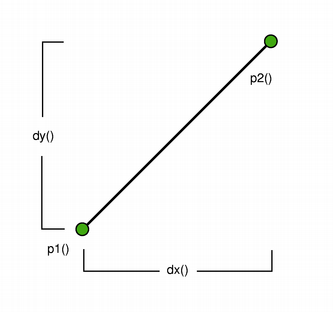 | 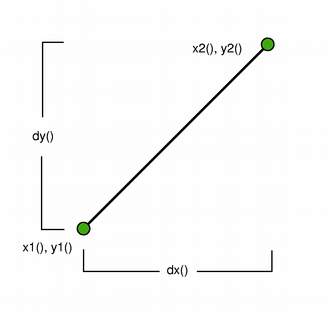 |
The positions of the line's start and end points can be retrieved using the p1(), x1(), y1(), p2(), x2(), and y2() functions. The dx() and dy() functions return the horizontal and vertical components of the line, respectively.
The line's length can be retrieved using the length() function, and altered using the setLength() function. Similarly, angle() and setAngle() are respectively used for retrieving and altering the angle of the line. Use the isNull() function to determine whether the QLineF represents a valid line or a null line.
The intersect() function determines the IntersectType for this line and a given line, while the angle() function returns the angle between the lines. In addition, the unitVector() function returns a line that has the same starting point as this line, but with a length of only 1, while the normalVector() function returns a line that is perpendicular to this line with the same starting point and length.
Finally, the line can be translated a given offset using the translate() function, and can be traversed using the pointAt() function.
See also QLine, QPolygonF, and QRectF.
Member Type Documentation
enum QLineF::IntersectType
Describes the intersection between two lines.
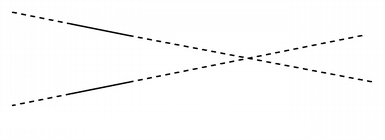 | 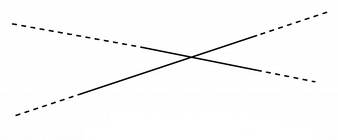 |
| QLineF::UnboundedIntersection | QLineF::BoundedIntersection |
| Constant | Value | Description |
|---|---|---|
| QLineF::NoIntersection | 0 | Indicates that the lines do not intersect; i.e. they are parallel. |
| QLineF::UnboundedIntersection | 2 | The two lines intersect, but not within the range defined by their lengths. This will be the case if the lines are not parallel. |
intersect() will also return this value if the intersect point is within the start and end point of only one of the lines.
| Constant | Value | Description |
|---|---|---|
| QLineF::BoundedIntersection | 1 | The two lines intersect with each other within the start and end points of each line. |
See also intersect().
Member Function Documentation
QLineF::QLineF ()
Constructs a null line.
QLineF::QLineF ( const QPointF & p1, const QPointF & p2 )
Constructs a line object that represents the line between p1 and p2.
QLineF::QLineF ( qreal x1, qreal y1, qreal x2, qreal y2 )
Constructs a line object that represents the line between (x1, y1) and (x2, y2).
QLineF::QLineF ( const QLine & line )
Construct a QLineF object from the given integer-based line.
See also toLine().
QPointF QLineF::p1 () const
Returns the line's start point.
See also setP1(), x1(), y1(), and p2().
QPointF QLineF::p2 () const
Returns the line's end point.
See also setP2(), x2(), y2(), and p1().
qreal QLineF::x1 () const
Returns the x-coordinate of the line's start point.
See also p1().
qreal QLineF::x2 () const
Returns the x-coordinate of the line's end point.
See also p2().
qreal QLineF::y1 () const
Returns the y-coordinate of the line's start point.
See also p1().
qreal QLineF::y2 () const
Returns the y-coordinate of the line's end point.
See also p2().
qreal QLineF::angle () const
Returns the angle of the line in degrees.
Positive values for the angles mean counter-clockwise while negative values mean the clockwise direction. Zero degrees is at the 3 o'clock position.
This function was introduced in Qt 4.4.
See also setAngle().
qreal QLineF::angleTo ( const QLineF & line ) const
Returns the angle (in degrees) from this line to the given line, taking the direction of the lines into account. If the lines do not intersect within their range, it is the intersection point of the extended lines that serves as origin (see QLineF::UnboundedIntersection).
The returned value represents the number of degrees you need to add to this line to make it have the same angle as the given line, going counter-clockwise.
This function was introduced in Qt 4.4.
See also intersect().
qreal QLineF::dx () const
Returns the horizontal component of the line's vector.
qreal QLineF::dy () const
Returns the vertical component of the line's vector.
QLineF QLineF::fromPolar ( qreal length, qreal angle ) [static]
Returns a QLineF with the given length and angle.
The first point of the line will be on the origin.
Positive values for the angles mean counter-clockwise while negative values mean the clockwise direction. Zero degrees is at the 3 o'clock position.
This function was introduced in Qt 4.4.
IntersectType QLineF::intersect ( const QLineF & line, QPointF * intersectionPoint ) const
Returns a value indicating whether or not this line intersects with the given line.
The actual intersection point is extracted to intersectionPoint (if the pointer is valid). If the lines are parallel, the intersection point is undefined.
bool QLineF::isNull () const
Returns true if the line is not set up with valid start and end point; otherwise returns false.
qreal QLineF::length () const
Returns the length of the line.
See also setLength().
QLineF QLineF::normalVector () const
Returns a line that is perpendicular to this line with the same starting point and length.
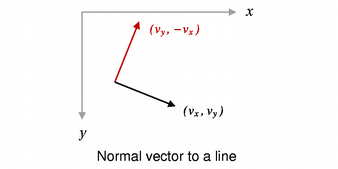
See also unitVector().
QPointF QLineF::pointAt ( qreal t ) const
Returns the point at the parameterized position specified by t. The function returns the line's start point if t = 0, and its end point if t = 1.
void QLineF::setP1 ( const QPointF & p1 )
Sets the starting point of this line to p1.
This function was introduced in Qt 4.4.
void QLineF::setP2 ( const QPointF & p2 )
Sets the end point of this line to p2.
This function was introduced in Qt 4.4.
void QLineF::setAngle ( qreal angle )
Sets the angle of the line to the given angle (in degrees). This will change the position of the second point of the line such that the line has the given angle.
Positive values for the angles mean counter-clockwise while negative values mean the clockwise direction. Zero degrees is at the 3 o'clock position.
This function was introduced in Qt 4.4.
See also angle().
void QLineF::setLength ( qreal length )
Sets the length of the line to the given length. QLineF will move the end point - p2() - of the line to give the line its new length.
If the line is a null line, the length will remain zero regardless of the length specified.
See also length() and isNull().
void QLineF::setLine ( qreal x1, qreal y1, qreal x2, qreal y2 )
Sets this line to the start in x1, y1 and end in x2, y2.
This function was introduced in Qt 4.4.
See also setP1(), setP2(), p1(), and p2().
void QLineF::setPoints ( const QPointF & p1, const QPointF & p2 )
Sets the start point of this line to p1 and the end point of this line to p2.
This function was introduced in Qt 4.4.
See also setP1(), setP2(), p1(), and p2().
QLine QLineF::toLine () const
Returns an integer based copy of this line.
Note that the returned line's start and end points are rounded to the nearest integer.
See also QLineF().
void QLineF::translate ( const QPointF & offset )
Translates this line by the given offset.
void QLineF::translate ( qreal dx, qreal dy )
This is an overloaded function.
Translates this line the distance specified by dx and dy.
QLineF QLineF::translated ( const QPointF & offset ) const
Returns this line translated by the given offset.
This function was introduced in Qt 4.4.
QLineF QLineF::translated ( qreal dx, qreal dy ) const
This is an overloaded function.
Returns this line translated the distance specified by dx and dy.
This function was introduced in Qt 4.4.
QLineF QLineF::unitVector () const
Returns the unit vector for this line, i.e a line starting at the same point as this line with a length of 1.0.
See also normalVector().
Returns true if the given line is not the same as this line.
A line is different from another line if their start or end points differ, or the internal order of the points is different.
bool QLineF::operator== ( const QLineF & line ) const
Returns true if the given line is the same as this line.
A line is identical to another line if the start and end points are identical, and the internal order of the points is the same.
Related Non-Members
QDataStream & operator<< ( QDataStream & stream, const QLineF & line )
Writes the given line to the given stream and returns a reference to the stream.
See also Format of the QDataStream Operators.
QDataStream & operator>> ( QDataStream & stream, QLineF & line )
Reads a line from the given stream into the given line and returns a reference to the stream.
See also Format of the QDataStream Operators.
Best Of
Actualités les plus lues
- Pourquoi les programmeurs sont-ils moins payés que les gestionnaires de programmes ? Manquent-ils de pouvoir de négociation ? 42
- Qt Commercial : Digia organise un webinar gratuit le 27 mars sur la conception d'interfaces utilisateur et d'applications avec le framework 0
- Interfaces mobiles : nouveaux usages, nouvelles ergonomies, par Miratech 0
- Implémentation d'une table de hachage à référence faible avec Qt, un article de Christophe Dumez traduit par Thibaut Cuvelier 4
- « Quelque chose ne va vraiment pas avec les développeurs "modernes" », un développeur à "l'ancienne" critique la multiplication des bibliothèques 94
- Apercevoir la troisième dimension ou l'utilisation multithreadée d'OpenGL dans Qt, un article des Qt Quarterly traduit par Guillaume Belz 0
- Les développeurs ignorent-ils trop les failles découvertes dans leur code ? Prenez-vous en compte les remarques des autres ? 17
- Pourquoi les programmeurs sont-ils moins payés que les gestionnaires de programmes ? Manquent-ils de pouvoir de négociation ? 42
- Quelles nouveautés de C++11 Visual C++ doit-il rapidement intégrer ? Donnez-nous votre avis 10
- Adieu qmake, bienvenue qbs : Qt Building Suite, un outil déclaratif et extensible pour la compilation de projets Qt 17
- 2017 : un quinquennat pour une nouvelle version du C++ ? Possible, selon Herb Sutter 7

- Linus Torvalds : le "C++ est un langage horrible", en justifiant le choix du C pour le système de gestion de version Git 100
- Comment prendre en compte l'utilisateur dans vos applications ? Pour un développeur, « 90 % des utilisateurs sont des idiots » 229
- Quel est LE livre que tout développeur doit lire absolument ? Celui qui vous a le plus marqué et inspiré 96
- Apple cède et s'engage à payer des droits à Nokia, le conflit des brevets entre les deux firmes s'achève 158
- Nokia porte à nouveau plainte contre Apple pour violation de sept nouveaux brevets 158
- Quel est le code dont vous êtes le plus fier ? Pourquoi l'avez-vous écrit ? Et pourquoi vous a-t-il donné autant de satisfaction ? 83
- Le Draft final de la norme C++ 0X validé 181

Le Qt Quarterly au hasard

Un plugin pour QImage
Communauté
Ressources
- 91 cours et tutoriels Qt
- F.A.Q. Qt : 200 questions et réponses
- 48 Qt Quarterly, 35 Qt Labs et 22 Qt DevNet en français
- 43 outils Qt
- 99 sources Qt
- 26 binaires Qt
- 6 livres Qt et 9 critiques
- La documentation de Qt 4.7 en français : 157 classes, 70 concepts et 24 modules
- 3 certifications Qt
Liens utiles
Contact
- Vous souhaitez rejoindre la rédaction ou proposer un tutoriel, une traduction, une question... ? Postez dans le forum Contribuez ou contactez-nous par MP ou par email (voir en bas de page).
Qt dans le magazine
| Cette page est une traduction d'une page de la documentation de Qt, écrite par Nokia Corporation and/or its subsidiary(-ies). Les éventuels problèmes résultant d'une mauvaise traduction ne sont pas imputables à Nokia. | Qt 4.6-snapshot | |
| Copyright © 2012 Developpez LLC. Tous droits réservés Developpez LLC. Aucune reproduction, même partielle, ne peut être faite de ce site et de l'ensemble de son contenu : textes, documents et images sans l'autorisation expresse de Developpez LLC. Sinon, vous encourez selon la loi jusqu'à 3 ans de prison et jusqu'à 300 000 E de dommages et intérêts. Cette page est déposée à la SACD. | ||
| Vous avez déniché une erreur ? Un bug ? Une redirection cassée ? Ou tout autre problème, quel qu'il soit ? Ou bien vous désirez participer à ce projet de traduction ? N'hésitez pas à nous contacter ou par MP ! | ||
Copyright © 2000-2012 - www.developpez.com



















